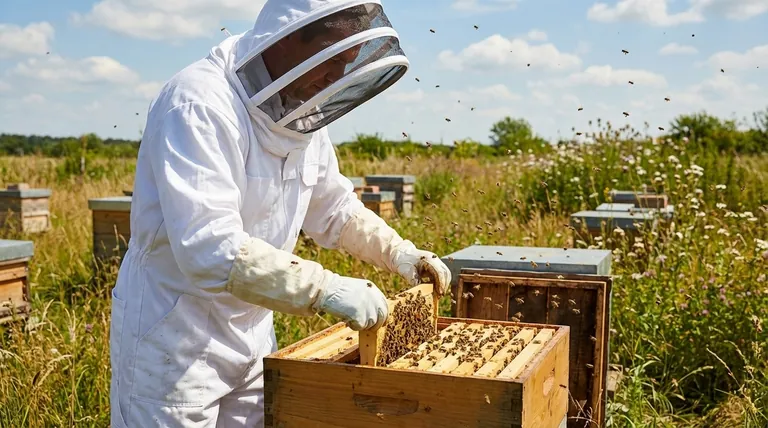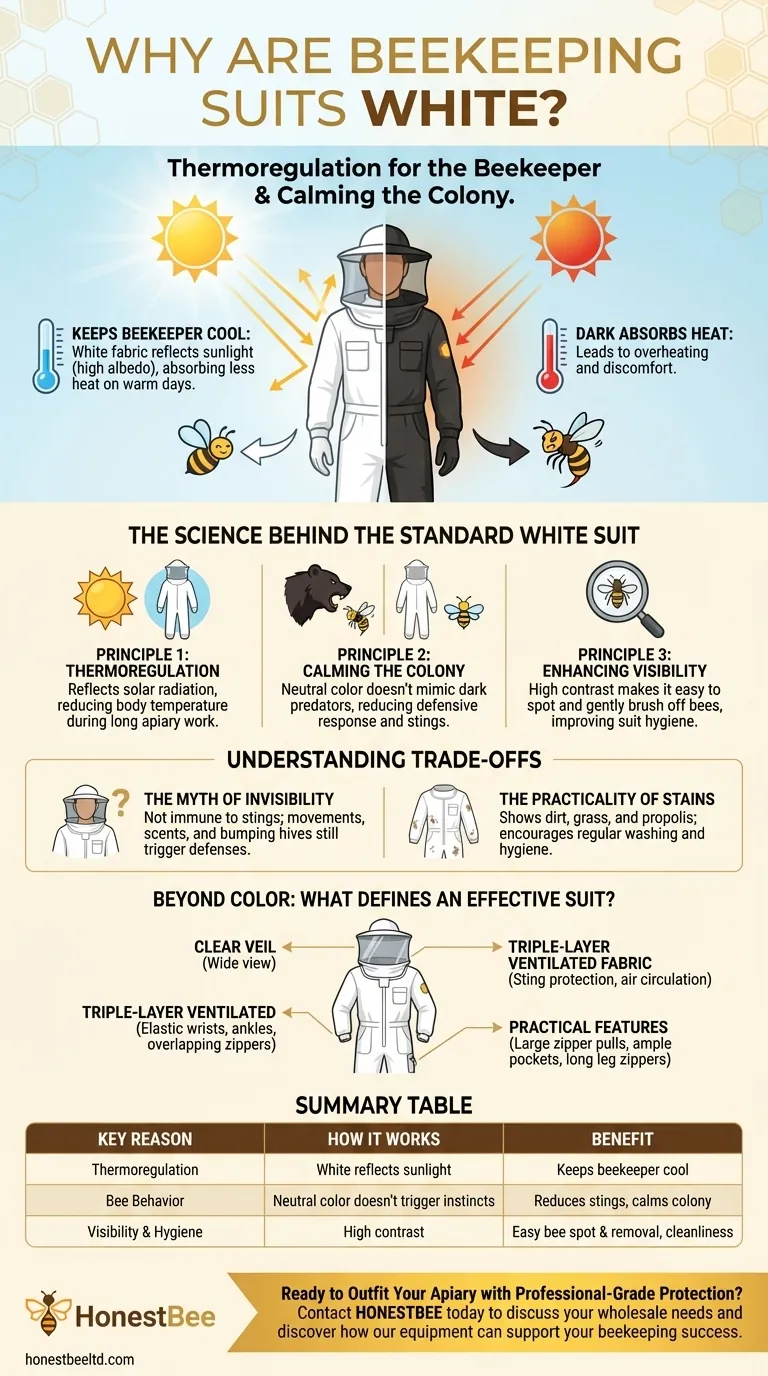In short, beekeeping suits are white for two fundamental reasons: to keep the beekeeper cool and to keep the bees calm. The white color reflects sunlight, absorbing less heat on warm days, while also being a neutral, non-threatening color from the bees' perspective, reducing defensive behavior and the likelihood of stings.
The design of a beekeeping suit is a deliberate balance between human comfort and bee biology. While the white color is the most visible feature, it's part of a larger system designed to make interactions with the colony as safe and stress-free as possible for both the beekeeper and the bees.

The Science Behind the Standard White Suit
A beekeeping suit isn't white by accident; it's the result of practical experience and an understanding of honeybee behavior. The color choice directly addresses the two most significant challenges of beekeeping: managing the environment and managing the colony.
Principle 1: Thermoregulation for the Beekeeper
Working in an apiary often means spending hours under the direct sun. A dark-colored suit would absorb a significant amount of solar radiation, quickly leading to overheating and exhaustion.
White fabric has a high albedo, meaning it reflects most of the sunlight that hits it. This simple principle of physics is crucial for keeping the beekeeper's body temperature down, allowing them to work more comfortably and safely for longer periods.
Principle 2: Calming the Colony
Honeybees have evolved over millions of years to defend their hives from natural predators. Many of these predators, such as bears, badgers, and skunks, are dark and furry.
Dark colors can trigger a bee's instinctive defensive response. A beekeeper wearing black or dark brown may be perceived as a threat, provoking stings. White is a neutral color that does not mimic a predator, making the beekeeper appear less threatening to the colony's guard bees.
Principle 3: Enhancing Visibility
A white background provides excellent contrast, making it much easier to spot individual bees that have landed on your suit. This allows you to gently brush them off instead of accidentally squashing them, an act that would release alarm pheromones and agitate the hive.
This high contrast also makes it easier to see dirt, propolis stains, or other contaminants, encouraging better suit hygiene.
Understanding the Trade-offs
While the benefits are clear, it's important to understand that a white suit is not a magic solution. It is a tool that mitigates risk, but it has practical limitations.
The Myth of Invisibility
A white suit does not make you immune to stings. It only removes one potential trigger. Other factors, such as jerky movements, strong perfumes, bad odors, or bumping the hive, can still provoke a defensive reaction. Calm, slow, and deliberate actions are just as important as the color of your suit.
The Practicality of Stains
The most obvious downside of a white suit is that it shows dirt, grass stains, and propolis (a sticky resin bees produce) very easily.
However, this can be seen as a benefit. A dirty suit reminds you to wash it, which is crucial for preventing the spread of disease between hives and removing any lingering alarm pheromones from previous inspections.
Beyond Color: What Defines an Effective Suit?
The color is a critical starting point, but the overall effectiveness of a beekeeping suit depends on its construction and features.
A High-Quality, Clear Veil
Your vision is paramount. A good suit has a durable and clear veil that offers a wide field of view without distortion. The veil should stand away from your face to prevent stings from reaching your skin.
Fabric, Fit, and Seals
Modern suits often use triple-layer ventilated fabric, which provides sting protection while allowing for air circulation. Equally important are the seals. High-quality elastic and velcro at the wrists and ankles, along with overlapping zippers, are essential for preventing bees from crawling inside the suit.
Features for Practical Use
Small details make a big difference during a hive inspection. Look for suits with large zipper pull rings that are easy to grasp with gloves on, ample pockets for carrying tools, and extra-long leg zippers that make it easy to put the suit on over boots.
Making the Right Choice for Your Goal
When selecting gear, consider how these features align with your specific needs.
- If your primary focus is maximum safety: Prioritize a suit with proven sting resistance, such as a triple-layer design, with overlapping zippers and tight elastic seals at all entry points.
- If your primary focus is comfort in a hot climate: A white, well-ventilated suit is non-negotiable to help manage heat during long inspections.
- If your primary focus is ease of use: Look for practical features like large zipper pulls, numerous pockets, and zippers at the ankles for convenience.
Ultimately, a quality beekeeping suit is a piece of professional equipment designed to make you a more effective and confident caretaker of your colonies.
Summary Table:
| Key Reason | How It Works | Benefit |
|---|---|---|
| Thermoregulation | White fabric reflects sunlight (high albedo) | Keeps beekeeper cooler and more comfortable during long inspections |
| Bee Behavior | Neutral color doesn't trigger defensive instincts like dark predator colors | Reduces likelihood of stings and calms the colony |
| Visibility & Hygiene | High contrast makes bees and dirt easy to spot | Allows gentle bee removal and encourages suit cleanliness |
Ready to Outfit Your Apiary with Professional-Grade Protection?
A high-quality beekeeping suit is essential for the safety and efficiency of your operation. At HONESTBEE, we supply durable, well-designed beekeeping suits and equipment specifically built for the demands of commercial apiaries and distributors.
Our suits feature the critical elements discussed—white, ventilated fabric, secure seals, and practical designs—to help you and your teams work more effectively and safely.
Contact HONESTBEE today to discuss your wholesale needs and discover how our equipment can support your beekeeping success.
Visual Guide

Related Products
- Cotton Beekeeping Suit and Round Hat with Veil Bee Keeper Protective Gear
- White Beekeeping Protective Suit and Hat with Fencing Veil for Beekeepers
- Professional Beekeeping Suit for Kids and Girls Childrens Bee Keeper Suit
- Beekeeper Cowboy Hat and Veil for Beekeeping
- Heavy Duty Cowboy Beekeeper Hat with Visibility Veil Outdoor Professional Beekeeping Protective Gear
People Also Ask
- Do beekeeping suits completely prevent stings? Maximize Your Apiary Safety with the Right Gear
- How should a bee suit be cleaned? Protect Your Investment and Ensure Apiary Safety
- How should a beekeeping suit be hung to maintain its shape? Protect Your Investment with Proper Storage
- What is recommended for beginners in beekeeping regarding protective clothing? A Complete Safety Guide for New Beekeepers
- Why is white the predominant color in bee suit designs? | Key to Hive Calm & Beekeeper Safety



















